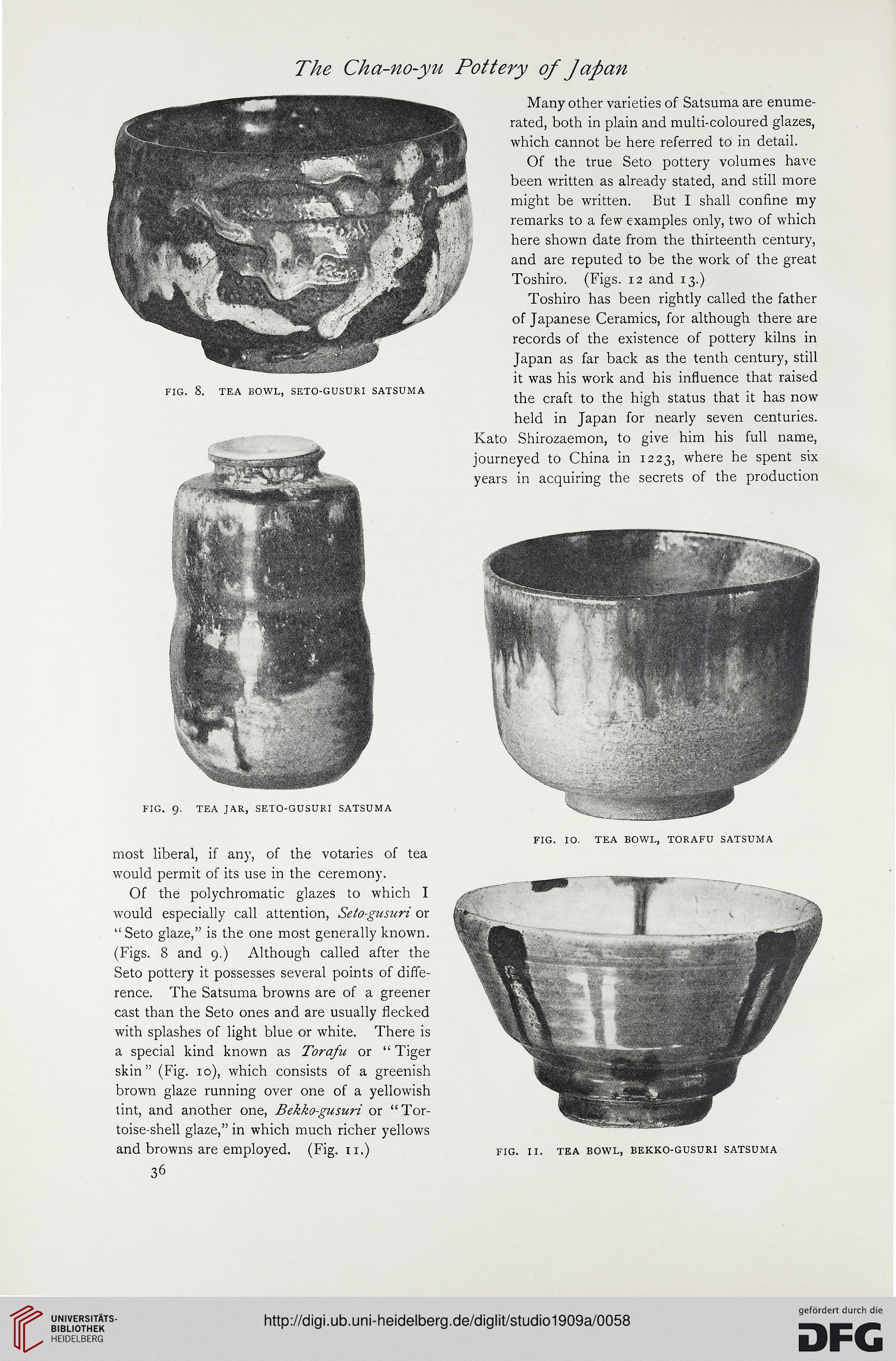The Cha-no-yu Pottery of Japan
FIG. 8. TEA BOWL, SETO-GUSURI SATSUMA
FIG. 9. TEA JAR, SETO-GDSURI SATSUMA
most liberal, if any, of the votaries of tea
would permit of its use in the ceremony.
Of the polychromatic glazes to which I
would especially call attention, Seto-gusuri or
“Seto glaze,” is the one most generally known.
(Figs. 8 and 9.) Although called after the
Seto pottery it possesses several points of diffe-
rence. The Satsuma browns are of a greener
cast than the Seto ones and are usually flecked
with splashes of light blue or white. There is
a special kind known as Torafu or “ Tiger
skin” (Fig. 10), which consists of a greenish
brown glaze running over one of a yellowish
tint, and another one, Bekko-gusuri or “Tor-
toise-shell glaze,” in which much richer yellows
and browns are employed. (Fig. n.)
36
Many other varieties of Satsuma are enume-
rated, both in plain and multi-coloured glazes,
which cannot be here referred to in detail.
Of the true Seto pottery volumes have
been written as already stated, and still more
might be written. But I shall confine my
remarks to a few examples only, two of which
here shown date from the thirteenth century,
and are reputed to be the work of the great
Toshiro. (Figs. 12 and 13.)
Toshiro has been rightly called the father
of Japanese Ceramics, for although there are
records of the existence of pottery kilns in
Japan as far back as the tenth century, still
it was his work and his influence that raised
the craft to the high status that it has now
held in Japan for nearly seven centuries.
Kato Shirozaemon, to give him his full name,
journeyed to China in 1223, where he spent six
years in acquiring the secrets of the production
FIG. IO. TEA BOWL, TORAFU SATSUMA
FIG. II. TEA BOWL, BEKKO-GUSURI SATSUMA
FIG. 8. TEA BOWL, SETO-GUSURI SATSUMA
FIG. 9. TEA JAR, SETO-GDSURI SATSUMA
most liberal, if any, of the votaries of tea
would permit of its use in the ceremony.
Of the polychromatic glazes to which I
would especially call attention, Seto-gusuri or
“Seto glaze,” is the one most generally known.
(Figs. 8 and 9.) Although called after the
Seto pottery it possesses several points of diffe-
rence. The Satsuma browns are of a greener
cast than the Seto ones and are usually flecked
with splashes of light blue or white. There is
a special kind known as Torafu or “ Tiger
skin” (Fig. 10), which consists of a greenish
brown glaze running over one of a yellowish
tint, and another one, Bekko-gusuri or “Tor-
toise-shell glaze,” in which much richer yellows
and browns are employed. (Fig. n.)
36
Many other varieties of Satsuma are enume-
rated, both in plain and multi-coloured glazes,
which cannot be here referred to in detail.
Of the true Seto pottery volumes have
been written as already stated, and still more
might be written. But I shall confine my
remarks to a few examples only, two of which
here shown date from the thirteenth century,
and are reputed to be the work of the great
Toshiro. (Figs. 12 and 13.)
Toshiro has been rightly called the father
of Japanese Ceramics, for although there are
records of the existence of pottery kilns in
Japan as far back as the tenth century, still
it was his work and his influence that raised
the craft to the high status that it has now
held in Japan for nearly seven centuries.
Kato Shirozaemon, to give him his full name,
journeyed to China in 1223, where he spent six
years in acquiring the secrets of the production
FIG. IO. TEA BOWL, TORAFU SATSUMA
FIG. II. TEA BOWL, BEKKO-GUSURI SATSUMA




